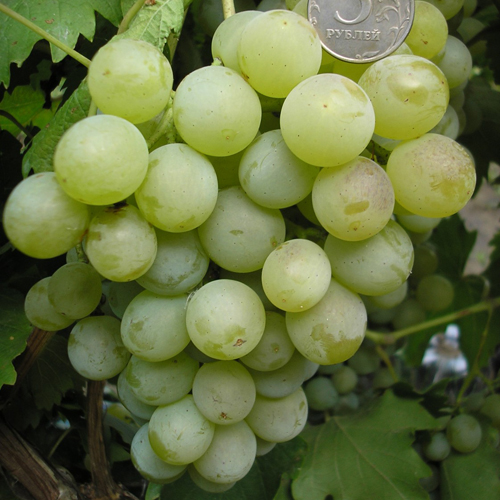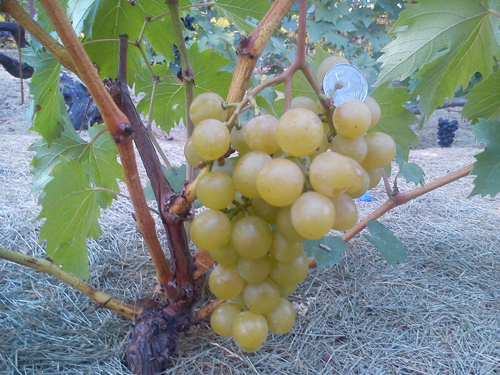Druzhba grape variety
The universal light-colored grape variety Druzhba is the fruit of the joint activity of domestic and Bulgarian breeders from the Scientific Research Institutes of Viticulture and Winemaking in Novocherkassk and Pleven, respectively. The variety was obtained as a result of crossing the complex-resistant wine variety Misket Kailishki with a hybrid under the working name XII 51/23. A characteristic fact of the pedigree can be considered the fact that the ancestor of both parents of our heroine is Muscat of Hamburg. The maternal form was born as a result of his crossing with Villard blanc, and the paternal form with the Zarya Severa. The famous European variety gave Druzhba the excellent qualities of a versatile grape suitable for consumption and processing into wine, while interspecific hybrids became the donors of genes for resistance and unpretentiousness in cultivation.

As a result, the international novelty combines a whole range of positive qualities, ranging from the bright taste and aroma of fresh berries, and ending with good resistance to a number of fungal diseases. And, of course, one cannot fail to mention those amazing drinks that can be made from this grape. They are distinguished by a strong memorable bouquet, lightness and quick ripening. Due to its qualities, the variety received official registration in the State Register of Breeding Achievements of the Russian Federation in 2002, and was recommended for cultivation on a production scale in the North Caucasus region of our country. Amateurs have spread the variety far beyond the zoned regions, and to this day it remains very popular among winegrowers who cultivate it in garden and garden plots for their own consumption.
For the sake of completeness, it is also worth clarifying that the table variety with the same name was bred in the distant Soviet times at the Central Asian Experimental Station of the VIR, however, due to its low resistance to disease and frost, it never became widespread. In this regard, under the name Druzhba, in the vast majority of cases, they mean precisely the Russian-Bulgarian universal variety.
Agrobiological characteristics
The vines of grape bushes range from low to medium. The crown of a young shoot is dark green, shiny, without pubescence. The leaves are not too large, rounded, mostly three-lobed with a weak dissection between the lobes. The leaf blade is wavy or flat, the upper side is rich green, reticulate-wrinkled, the back is covered with weak cobweb-type pubescence. Lateral notches, as a rule, are small, V-shaped, may be barely outlined, or completely absent. The petiolate notch is in most cases vaulted, with a rounded or pointed bottom. The petioles are comparable in length with the main vein of the leaf, and are colored greenish-pink due to the presence of anthocyanin pigmentation. The teeth along the perimeter of the leaf blade are rather large, usually triangular, elongated in length with even edges and narrow bases. The flowers form bisexual, due to which pollination problems occur only in the most unfavorable weather conditions. Berries are rarely peas, and ovary shedding is not noticed. Ripening of one-year growth is good - usually not less than 85% of the length of the shoots. The color of the ripe vine is dull brown.

Ripe bunches of grapes are of medium size, reaching a length of 20 cm and an average weight of 250-300 grams. The shape of the brushes of this variety is cylindrical-conical or winged, the structure is loose or of medium density. A good single-caliber grape gives the well-executed bunches of Friendship elegance and attractive appearance, which, moreover, due to the not too dense arrangement in relation to each other, do not wrinkle or deform.Moderately long combed feet securely attach the brush to the vine, while remaining herbaceous, pinkish-green in color. The berries grow round, with a diameter of about 22-23 mm and a weight of about 4 grams. Their color is white with a faint greenish tinge, the surface is covered with a thick light prune bloom. The pulp of the fruit is tender, very juicy, excellent for obtaining must in winemaking, however, when tasting fresh, the consistency is sometimes assessed as watery. The taste is harmonious, refreshing, the aroma is stunningly bright - nutmeg. The juice yield exceeds 70% of the crop mass, its sugar content reaches 19-21 g / 100 ml, the titratable acidity is 6-8 g / l. The skin is thin, translucent, easy to chew when eaten, but strong enough to be damaged by insects. The seeds are contained in small quantities, having little effect on the taste of the berries. The gastronomic ratings of the fresh grapes are above average and the drinks made from them are simply excellent. Dry wines get about 8.6 points during tasting, sparkling wines - 9.2-9.4 points.
These circumstances determine the versatility of the harvested crop. Large volumes of grapes grown in amateur farms are immediately consumed directly for food. Among farmers dealing with table varieties for sale, our heroine is not particularly popular due to the modesty of her commercial qualities in comparison with many large-fruited varieties. Juicy berries also do not have high transportability and keeping quality during storage. But in terms of technology, Friendship is exceptionally good. It is widely used to produce high-quality alcoholic and non-alcoholic beverages with an unusually strong nutmeg aroma. Even a small addition of wine material from this variety to the blend enriches the overall bouquet of the finished drink with bright attractive tones.

The ripening period of our heroine is considered early, and in the climatic conditions of the traditional wine-growing regions of our country, the bunches are ready to be harvested at the end of the second - beginning of the third decade of August. The growing season from budding in the spring until the onset of removable ripeness is 120-130 days, and the required amount of active temperatures reaches 2500-2600 ° C. These parameters indicate the possibility of cultivating the variety not only in the south, but also in most areas of the Central Black Earth Zone, which is confirmed by many amateur winegrowers. On the northern border of this region, the harvest, however, can only be used for food and for processing into juice and other conservation, since the sugar in grapes will most likely be insufficient for winemaking. It is imperative that when moving north, you should pay attention to the frost hazard of the local climate in winter, and soberly correlate the existing values with the frost resistance of plants not exceeding -23 ° C. If it is necessary to protect the bushes from the winter cold, they are formed according to standard-free schemes, raising them low from the ground in order to be able to remove the vine from the trellis in the fall and insulate it.
Druzhba's yield is estimated as high - 150-180 kg / ha, although its potential productivity is even higher. So, the percentage of fruitful shoots reaches 70-80%, and the number of clusters per shoot is 1.1-1.5. Bushes can be subject to overload, and to prevent this, they are rationed annually by shoots and harvest in accordance with the vital energy, size and age of the plants. Ignoring such measures can lead to a lengthening of the growing season, a decrease in the growth force of shoots, and a deterioration in the quality of the crop.
For winemaking, the harvest is removed from the bushes when fully ripe, allowing the grapes to accumulate maximum sugar conditions and normalize acidity. In the case of our heroine, this is not difficult, sincethe berries are not prone to cracking during a long stay on the vine, and a problem of this kind may appear only after a very long rainy period. Wasps also bypass the harvest, despite the seemingly thin skin of the fruit. Plants have good innate resistance to gray rot, as well as to mildew. But against powdery mildew, they must be repeatedly treated with fungicides.
The variety is propagated mainly in a grafted culture, using forms such as Berlandieri x Riparia Kober 5 BB and Chassela x Berlandieri 41 B as rootstocks, with which Friendship has a good affinity.








